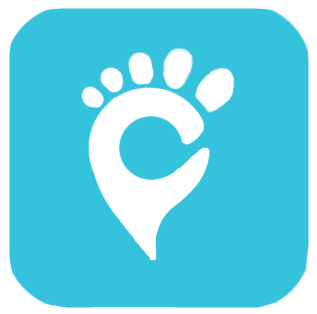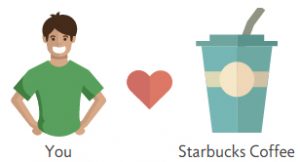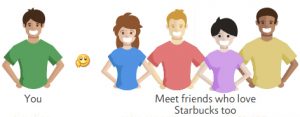Chinese Startups Social Network:

What is Gogo?
Gogo is a social network platform intended to connect between people, their interests, and the businesses behind their interests! Described as a combination between Facebook and Four Square, Gogo allows users to present snippets of their life while meeting people who share their passions. Simultaneously, an intricately designed badge system segments the users into numerous categories based on their personal hobbies, and allows them to further develop their passions by engaging in activities related to their interests. As the user continues to participate in their favorite pastime, they are able to ascend to higher rankings within their chosen category, and acquire higher-level badges that prove their dedication to the field. Furthermore, with every level ascension, the user enjoys added perks related to their interests- such as discounts, membership access, free merchandise and more. Living up to its name, Gogo allows its users to truly immerse themselves in the worlds of their favorite things, and “go-go” be their best at it!
What stage of development is Gogo currently in?
Gogo was founded in October 2015 and is currently in the product testing stage. While it is not yet open to the public, the company already has a large business client list. Both the application and website are expected to be opened to the public in August 2016.
How does the badge system work?
The badge system’s purpose is three-fold. It serves to both connect you to others who share your passions, prove the extent of your dedication to the field, and allow you to interact and be rewarded for your loyalty by the very businesses related to your interest. So how exactly does this work? Let’s say a user is a Starbuck’s coffee lover…
 Connect to your interests: Badges act like tags. As an avid Starbucks lover, users can add the Starbucks badge to their official interest list on their profile. This essentially connects them to the “Starbucks world”. They can then learn more about the particular badge and the steps they need to take to advance in their Starbucks coffee badge rankings.
Connect to your interests: Badges act like tags. As an avid Starbucks lover, users can add the Starbucks badge to their official interest list on their profile. This essentially connects them to the “Starbucks world”. They can then learn more about the particular badge and the steps they need to take to advance in their Starbucks coffee badge rankings.
 The Facebook Aspect: Once adding Starbucks as a new interest, users can start posting about their love for the brand and document their chronicles at Starbucks shops! While doing so, Gogo connects them to other people who share their love of coffee, allowing users to meet and interact with new coffee mates!
The Facebook Aspect: Once adding Starbucks as a new interest, users can start posting about their love for the brand and document their chronicles at Starbucks shops! While doing so, Gogo connects them to other people who share their love of coffee, allowing users to meet and interact with new coffee mates!
 The Badge Ranking & Authentication System, Prove Your Dedication: Once the user has familiarized themselves with their chosen badge ranking system, they can begin to follow the steps to advance in badge levels. For example, a user might need to scan a QR code to prove they have purchased a coffee, or perhaps ‘check in’ on Gogo at a Starbucks shop, etc… Based on the businesses’ predetermined individual ranking model, the more a user engages with the product/interest and completes the necessary action to advance a level, the higher their badge ranking in the category becomes! All the while, users join the badge’s “community” where they can share their experiences with like-minded coffee-friends, join relevant discussion groups, and even segment all their Starbucks friends into badge levels. As not everyone’s extent of coffee-love is the same, this segmentation allows users to directly interact with other people who have the same degree of dedication and badge level as them. Exclusive groups can further be created between members who have reached a certain badge level.
The Badge Ranking & Authentication System, Prove Your Dedication: Once the user has familiarized themselves with their chosen badge ranking system, they can begin to follow the steps to advance in badge levels. For example, a user might need to scan a QR code to prove they have purchased a coffee, or perhaps ‘check in’ on Gogo at a Starbucks shop, etc… Based on the businesses’ predetermined individual ranking model, the more a user engages with the product/interest and completes the necessary action to advance a level, the higher their badge ranking in the category becomes! All the while, users join the badge’s “community” where they can share their experiences with like-minded coffee-friends, join relevant discussion groups, and even segment all their Starbucks friends into badge levels. As not everyone’s extent of coffee-love is the same, this segmentation allows users to directly interact with other people who have the same degree of dedication and badge level as them. Exclusive groups can further be created between members who have reached a certain badge level.
 Increase in Rank and Earn Rewards: When users advance in any badge rank, their profile picture will adjust per category to show their current badge level. Each category and brand has its own determined reward and perk-system that gifts the user for their proven brand loyalty or dedication to the field. For example, Starbucks may issue membership cards to higher-ranking Starbucks badge owners.
Increase in Rank and Earn Rewards: When users advance in any badge rank, their profile picture will adjust per category to show their current badge level. Each category and brand has its own determined reward and perk-system that gifts the user for their proven brand loyalty or dedication to the field. For example, Starbucks may issue membership cards to higher-ranking Starbucks badge owners.
How many badges are there?
Currently the Gogo platform holds over 300 different badges, ranging from brands, to sports teams, films, celebrities, books, general hobbies and more. Each of these badges has its own specific badge-advancement and reward system. For brands, movies, or celebrities, each entity has its own agreements with Gogo. As such, Gogo’s growth potential is massive, as it can infinitely grow by creating more cooperation with businesses, as well as increase badges and customization options for its users.
Examples:
 Celebrities: Celebrities too can have their own badges. To increase ranking in an ‘Ellen DeGeneres’ badge, for example, a user would have to prove they’re a huge fan by following Ellen’s official Gogo page, live-tweet an episode on their Gogo page, etc… A reward for advancing the ranks could be Ellen merchandise or even tickets to the show.
Celebrities: Celebrities too can have their own badges. To increase ranking in an ‘Ellen DeGeneres’ badge, for example, a user would have to prove they’re a huge fan by following Ellen’s official Gogo page, live-tweet an episode on their Gogo page, etc… A reward for advancing the ranks could be Ellen merchandise or even tickets to the show.
General Hobbies: Badges do not have to be brand specific, and can also cover general hobbies such as photography. To gain rank and improve in photography badges for example, users can prove their photography prowess by amassing a certain number of likes per picture. The reward in this case could even be scoring a magazine photography contract for proving skill and positive audience reception in this field.
Sports Teams: If a user is a Lakers fan, they can improve in the Lakers badge rank by purchasing tickets to Lakers games. An eventual reward could be free tickets to future games.
Note: The above images are only representations of the Gogo badges. The real badges are designed by a Gogo team member and are customized and specialized to the badge category.
Are there similar companies to Gogo?
Gogo is loosely based on the American travel application, Gogobot. While the two sites are similar in that users can share reviews and select interests, Gogo adds several entirely new dimensions to the Gogobot foundation such as the reward system, boundless badge categories and fully operational social media platform. Gogobot is intended to be a platform for travel-related review alone, and has a simplistic social media platform that only allows for public forum discussions or otherwise linking to preexisting social media. Conversely, Gogo’s social media platform is built-in to the application and allows for direct messaging, profile posts, and targeting specific like-minded users that can be added as friends. Furthermore, unlike Gogobot badges that are virtual trophies, Gogo badges represent physical prizes that can be acquired, and prove authenticity in your knowledge of the field.
Why is it necessary for a user to prove and authenticate their dedication?
The element of trust is a significant cultural value in China. Despite the Internet’s vast and widespread international use, one of the most common problems it brings is the simplicity with which people can lie and present misinformation on it. Therefore, building trust on the Internet is a huge problem in China, and requiring proof to authenticate the validity behind written words is very important to both brands as well as users. By physically providing evidence to back up claims, be it that a user actually has bought a Starbucks coffee, or can take good quality pictures than can amass 1000s of likes, the Gogo users are verifying to both the company and other users that the information they are sharing is both true and reliable. So when a company grants rewards, or a user decides to message a fellow Laker’s fan, they can be sure what they see on the feed is not fabricated.
B2C: What added value does Gogo provide its users?
Customization: Beyond its database of users’ preferences and interests, Gogo can further identify the spectrum and extent of each users’ interest in a particular topic. This data allows users to fully customize their connections list by specifying what kind of people can add them as friends. For example, a user who is a badge level 3 Lakers’ fan may make a setting that only accepts friend requests from fellow Lakers fans who are of the same level.
Exposure to new things: An added Gogo feature is a weekly “Virtual Festival” which introduces a new badge and community to users for a limited time frame. This allows users to meet people who hold entirely different interests from their own, thereby exposing them to new fields and new friends who might otherwise have never crossed paths.
Incentive: The badge ranking system further provides incentive for users to strive to be their best at whatever interest they hold. If a user is an avid skier, they are driven to push themselves and conquer more challenging slopes so as to ascend a badge level and perhaps earn discounts on their next ski trip.
B2B: What added value does Gogo provide the brands it works with?
Valuable Information: Like the users, brands who have a Gogo official page and badge are able to distinguish their consumers’ different level of interest in their product and target content to them appropriately. Brands are also able to attain other valuable information about their consumers such as demographics.
Brand Loyalty & Visibility: Gogo promotes brand loyalty and helps improve brand visibility. The Gogo platform endorses brands through the most organic form of advertising- word of mouth.
Communication Platform with Consumers: Gogo provides an easy platform for brands to interact with their consumers and hear their needs. This communication allows for better customer service and makes the brands more approachable.
What is Gogo’s Business Model?
Gogo’s business model is based on advertisements, which can be targeted per interest. Furthermore, users will be able to play games related to their interests as a possible way to advance in badges. Gogo will receive commission from the inclusion of these customized games on their platform. Brands and users can join and use the platform free of charge.
What is Gogo’s Marketing Strategy Once it Goes Public?
The Gogo application is projected to have a large audience due to its all-encompassing marketing strategy. In August when the Gogo platform is opened to the public, each of the roughly 300 brands associated with the company will start promoting it. As the former PR president of the Chinese Student Association in Australia, the company’s CEO will further promote the platform through this channel and have access to the association’s large user database. Finally, the Gogo company is currently housed under UrWork, a startup incubator, and as such is able to distribute and promote the app through the many UrWork channels of communication.
Has Gogo thus far received any funding?
Gogo has most recently received an angel investment from a VC firm in Shanghai.
Meet the team!
 Qiu Xi (Carter): Carter is the CEO of Gogo. Originally from Liaoning, Carter completed his undergraduate degree in Australia’s Macquarie University, majoring in accounting. Carter’s work experience includes 3 prior entrepreneurial ventures, as well as working for JP Morgan in Hong Kong. While in Australia, Carter founded a successful website entitled “Love Sydney” (爱悉尼). The platform was intended to assist local Chinese living in the Australian metropolis learn more about the city. It recorded roughly 170,000 users or almost 20% of the Chinese population in Australia. The company was later sold to a local financial company.
Qiu Xi (Carter): Carter is the CEO of Gogo. Originally from Liaoning, Carter completed his undergraduate degree in Australia’s Macquarie University, majoring in accounting. Carter’s work experience includes 3 prior entrepreneurial ventures, as well as working for JP Morgan in Hong Kong. While in Australia, Carter founded a successful website entitled “Love Sydney” (爱悉尼). The platform was intended to assist local Chinese living in the Australian metropolis learn more about the city. It recorded roughly 170,000 users or almost 20% of the Chinese population in Australia. The company was later sold to a local financial company.
Yi Zhou: Yi Zhou is the Chief Technology Officer (CTO) of Gogo. He holds a Bachelor of Science Degree in Software Engineering from Zhejiang University of Technology, and furthermore holds a Masters of Science in Computer Science from Beihang University. Yi Zhou previously served as a mobile app developer for Tencent’s WeChat, and has most recently worked as a tech leader of multiple projects for Google’s G-mail.
For more information:
Website: www.Gogoes.cn (Coming soon!)
This company has been remodeled. Read about the updated company, Loop, here.
